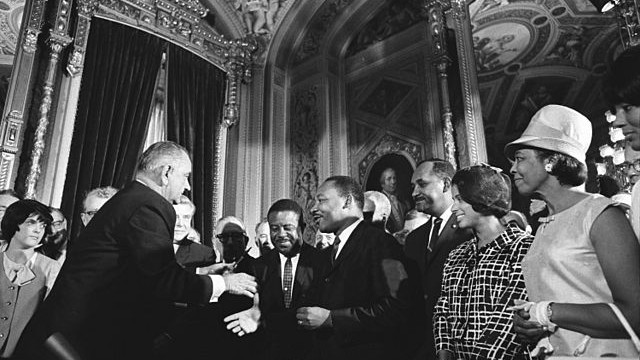
This post originally appeared on the Brennan Center for Justice blog.
Congress went home last week without tackling several critical issues facing our country. This is common in an election year. But this year should have been different. For the first time in nearly five decades, Americans will go to the polls in November without a key protection under the Voting Rights Act, which the US Supreme Court gutted last year in Shelby County v. Holder. When Congress comes back in September, leaders of both parties must act to ensure every citizen can freely cast a ballot.
As we mark the 49th anniversary of the signing of the Voting Rights Act this week, it’s worth looking back at how far our nation has come on voting discrimination and race, and how we can move forward together to ensure equality and justice for all.
The America we knew in 1965 was vastly different than the one we know now. The civil rights struggle showed our country through a black and white prism. President Lyndon Baines Johnson spoke of this race divide when he signed the VRA, which made it illegal for states to discriminate based on race in voting.
“The stories of our Nation and of the American Negro are like two great rivers,” he said, “flow[ing] through the centuries along divided channels.” Only after the Civil War, Johnson remarked, did the two rivers begin “to move toward one another.” And a century later, the VRA would allow the two currents to “finally mingle and rush as one great stream across the uncertain and the marvelous years of the America that is yet to come.”
The Voting Rights Act was designed to help African Americans in the South participate in our democracy. But in the years since, it has been modernized to include many more citizens who need our help, just as Johnson and Congress intended. It was expanded to include Latinos and helped protect them from restrictive voting and redistricting maneuvers. It now includes Native Americans, and has helped protect polling places on tribal lands. And it also safeguards Asian Americans, who can receive ballots in their native language in states across the country.
America is no longer made of two great rivers, flowing along divided channels. We are now a grand delta flowing into the great American ocean.
And just as our country is more racially diverse now than it was 49 years ago, it also faces more expansive challenges. I was reminded of this during a recent visit to the newly-minted National Center for Civil & Human Rights, where I saw how the freedoms and protections that were of concern to 1965 America have expanded to include so many other fundamental issues.
Our criminal justice system houses 25 percent of the world’s prisoners, despite having only 5 percent of the world’s population. People of color are much more likely to fall victim to this system of mass incarceration. Our education system routinely fails inner-city and rural kids, who are poorer and more diverse than the rest of the country. And while same-sex marriage victories have swept through courtrooms across the nation, discrimination is still a serious problem in the LGBT community.
The link between civil and human rights — a nexus that was practically foreign 49 years ago — is now undeniable. Voting rights is the glue that holds that bond together.
If we are to remain and grow as a democracy, we must continue to strengthen and expand the voting franchise. Only by allowing myriad voices to speak out at the ballot box can we begin to solve the vital human rights challenges facing America today.
The Voting Rights Act has never been a partisan issue. It passed by a wide margin and was last reauthorized in 2006, nearly unanimously.
But Congress left town without moving forward on a bill to help modernize and strengthen it in the wake of last year’s Supreme Court ruling. The Voting Rights Amendment Act was introduced in January by Rep. Jim Sensenbrenner (R-WI) and Sen. Patrick Leahy (D-VT). The Senate held one hearing on the bill, but the House has failed to act.
In signing the VRA, LBJ explained how the Civil War marked a promise that was never fulfilled. “Today is a towering and certain mark that, in this generation, that promise will be kept,” he said.
The views expressed in this post are the authors’ alone, and presented here to offer a variety of perspectives to our readers.


